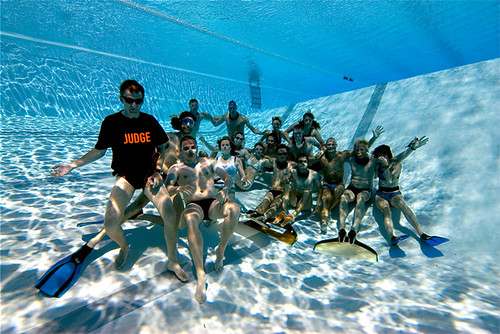The idea is to have a fast system for the retrieval of a freediver at depth. The freediver is connected to the rope by a lanyard. In case of an emergency at depth, the counter ballast is released on the opposite side in order to pull up the bottom weight of the rope and the freediver hanging on the bottom by means of his lanyard.
The system was developed in order to cope with greater depth in competitive freediving and the risks for a scuba safety diver.

Exampel of a CBS designed and manufectured by Olivier Haug.
A CBS consists of the following elements:

1. Rope
2. Bar
3. Two pulleys
4. Brake
5. Two to three weights
 The setup is quite simple. At the end of the bar you would put the pulleys and let the rope run through them. The brake is located between them.
The setup is quite simple. At the end of the bar you would put the pulleys and let the rope run through them. The brake is located between them.In my setup, I’m using three weights. The weight on the bottom and the weight on the other side are exactly the same keeping the system in balance. This is making the handling of the system a lot easier and both lines are hanging straight in the water. A third weight is secured at the bar (at the counter ballast side) and connected to the rope with another lanyard. The brake is holding the (balanced) rope in position.
All of the elements should fulfill certain criteria in order to make the whole thing run:
- 1. The rope
- a. AIDA International has specified the thickness of ropes used in competitions. Using a static rope with a diameter of between 10 and 12 mm for CWT, CNF and FIM is recommended.
- b. The rope needs to be at least 10m longer than the maximum depth of the dive.
- 2. The bar
- a. Should be long enough to keep the two ends of the rope apart from each other. Minimum 4 m. If you prepare for a -70m dive and release the CBS the two weights (including the diver) will pass each other in -35m depth. There, the distance should be big enough to assure no entanglement is taking place.
- b. In case you are using a boat or a platform to mount the CBS on, the bar should be looking over the edges for more than 1,5m in order to assure that neither the athlete nor the safety freediver hit the boat/platform when surfacing.
- 3. The pulleys
- a. They should be sufficiently wide. As some ropes tend to be swelling in the water it is recommended to take one that is 2mm wider than your rope.
- b. It is very good to have pulleys that can be opened in order to remove the rope. Then you will be able to change the setting without running all the rope through it.
- 4. The brake
- a. Can be as simple as a cleat.
- b. Needs to be released quickly.
- c. If you are using a rope clutch or cam cleat, it needs to be sufficiently wide (see pulley)
- 5. The weights
- a. The bottom weight/counter weight should be sufficient for the discipline you are diving in. It needs to keep the line still and avoid it from moving very much even if the diver should touch or kick it with the fin. 5 kg should be enough for CWT and CNF if there is no current. For FIM you would choose between 15 and 20 kg to keep the bottom stable even when the diver is pulling himself down.
- b. For the extra weight to retrieve the diver AIDA International is suggesting a minimum of 15 kg.
 To release the CBS you simply release the break and drop the extra weight at the counter ballast side. Then, in addition to the weight, two men should start pulling up the rope.
To release the CBS you simply release the break and drop the extra weight at the counter ballast side. Then, in addition to the weight, two men should start pulling up the rope.Things that can go wrong:
- The rope can jump out of the pulley and jam.
- The two ends of the rope can entangle and stop the movement.
- The counter weight can hit the freediver, the safety diver or anybody diving around that area.
- The lanyard can break.
- If the rope is too long the counter weight can hit the bottom before the diver is up at the surface.
- Many more things we cannot think of…
On 24th of May 2009 we tested the couter ballast system installed at the platform at the Kreidesee in Hemmoor in a safety drill.
Elisabeth Kristoffersen was diving down to a depth of -40m attached to the main line by a lanyard on her wrist. Upon arrival at the bottom plate she pulls so the surface crew knows, she is ready.
Then, the break is released so the counter ballast sets in and two men pull the rope up in addition. The pulling style is from the Skandalopetra diving.
It takes 41 seconds for Elisabeth to dive dow and only 34 seconds for her retrieval, including 5-6 seconds to release the weights.
Safety: Daan Verhoeven and Igor Migonov
CBS: Christian Ernest and Jens Berger
Always remember: a system is only as good as the people handling it! Do trials, educate your surface crew and keep all parts clean and running.





